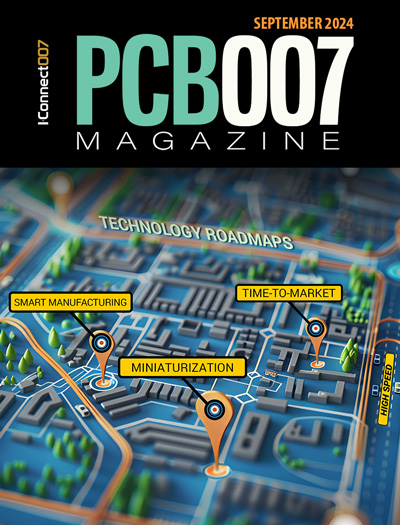-

- News
- Books
Featured Books
- pcb007 Magazine
Latest Issues
Current Issue
Engineering Economics
The real cost to manufacture a PCB encompasses everything that goes into making the product: the materials and other value-added supplies, machine and personnel costs, and most importantly, your quality. A hard look at real costs seems wholly appropriate.

Alternate Metallization Processes
Traditional electroless copper and electroless copper immersion gold have been primary PCB plating methods for decades. But alternative plating metals and processes have been introduced over the past few years as miniaturization and advanced packaging continue to develop.

Technology Roadmaps
In this issue of PCB007 Magazine, we discuss technology roadmaps and what they mean for our businesses, providing context to the all-important question: What is my company’s technology roadmap?
- Articles
- Columns
Search Console
- Links
- Media kit
||| MENU - pcb007 Magazine
Designing for Cost to Manufacture
November 21, 2024 | Marcy LaRont, I-Connect007Estimated reading time: 2 minutes
ICAPE's Richard Koensgen, a seasoned field application engineer with a rich background in PCB technology, shares his journey of working with customers and manufacturers through the intricacies of circuit board development and emphasizes the importance of early-stage collaboration with PCB designers. With a focus on tackling the most challenging aspects of PCB design and manufacturing, he discusses everything from layout considerations to the thermal challenges of today's technology when it comes to designing for cost.
Marcy LaRont: Richard, please tell me about your background and your role at ICAPE.
Richard Koensgen: I work for ICAPE Group in Germany as a field application engineer. Essentially, if you're doing something really tricky with your PCB or your project—maybe you run the danger of nobody being able to manufacture it in the first place—that’s when I get involved.
LaRont: How long have you been working in the PCB industry?
Koensgen: I started working in this industry in 2016 for a company that was later acquired by the ICAPE Group. At that time, I was mostly handling customer complaints. So, I essentially learned my trade by aligning customer expectations with reality, or the other way around. How do we learn best? Usually, it’s when something is broken and you need to understand what's going on. Fixing a symptom can be easy. Fixing the root cause is a little bit harder.
LaRont: You are helping your customers resolve manufacturing issues causing defects by performing root cause analysis.
Koensgen: Yes, and sometimes a customer doesn’t even know where to start. I saw a board once that had the copper traces nearly burned away. They weren’t dimensioned properly, and there was too much current flowing through. The corresponding trace for the power that went through it got hot and literally burned away. That was my profile picture on Microsoft Teams for quite some time.
LaRont: ICAPE Group is a manufacturer that engages across the PCB technology spectrum. What are your customers most challenged by?
Koensgen: Usually only the very special situations end up on my table. But more commonly, I’ve seen requests for standard layout stackups to meet their requirements, customers asking for something that has already been proven based on their impedance requirements, etc. They may be running into the danger of needing exotic materials because nowadays, even if you look at just a USB port 3.0, it’s a high-frequency connection. You need to think about the impedance of your USB connector.
LaRont: That makes sense.
Koensgen: I've encountered it enough that I created a webinar all about impedance, and that example is part of my introduction. I had a customer who was unaware he had an impedance-controlled connection on his PCB when he switched the build to us. He didn't provide any documentation regarding layer stackup or impedance. So, of course, our manufacturer used the most standard, cost-effective stackup. Now, the trick about USB controllers is they are so well designed they will detect a misconfiguration on the impedance and throttle down or fall back to an earlier version’s performance standards so the drivers and transistors don't get damaged.
To read this entire conversation, which appeared in the November 2024 issue of PCB007 Magazine, click here.
Suggested Items
I-Connect007 Editor’s Choice: Five Must-Reads for the Week
11/22/2024 | Andy Shaughnessy, I-Connect007In this week’s roundup, I’m highlighting a variety of articles. We have an interview with Jess Hollenbaugh, a recent graduate working for Polar Instruments. We also have an interview with IPC’s Matt Kelly and Devan Iyer, whose white paper may provide a way forward for companies dealing with complex advanced packages. Our newest columnist Tom Yang describes the U.S. PCB industry from the point of view of a technologist from another country, and Dan Beaulieu has a review of Malcolm Gladwell’s follow-up to The Tipping Point. Finally, we have my review of PCB Carolina, a one-day tabletop show that keeps expanding, much like my waistline after eating their catered food. Enjoy!
North American PCB Industry Sales Down 11.1% in October
11/22/2024 | IPCIPC announced today the October 2024 findings from its North American Printed Circuit Board (PCB) Statistical Program. The book-to-bill ratio stands at 1.09.
Real Time with... electronica 2024: Inside CEE PCB—Innovations in Technology
11/22/2024 | Real Time with... electronicaMarcy LaRont Interviews Tom Yang and Jerome Larez From CEE PCB. Tom and Jerome showcase the company's advancements and emphasize the importance of automation in PCB manufacturing for quality and efficiency. The CEE PCB focuses on sustainability and aims to connect with high-tech clients while exploring new partnerships for high-volume production.
PCB Design Software Market Expected to Hit $9.2B by 2031
11/21/2024 | openPRThis report provides an overview of the PCB design software market, detailing key market drivers, challenges, technological advancements, regional dynamics, and future trends. With a projected compound annual growth rate (CAGR) of 13.4% from 2024 to 2031, the market is expected to grow from USD 3.9 billion in 2024 to USD 9.2 billion by 2031.
Global Citizenship: What I’ve Learned About the American PCB Business
11/20/2024 | Tom Yang -- Column: Global CitizenshipNavigating the complexities of the American PCB business has been an eye-opening experience. During my time in America, I have become more familiar with the American PCB business and doing business here. If I may, and with your indulgence, I would like to share my humble impressions of the American PCB industry and the American way of doing business, which I find interesting and admirable.


